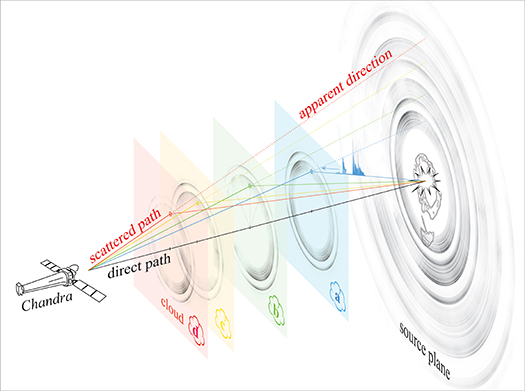'Listen' to the Light Echoes From a Black Hole
Credit: X-ray: Chandra: NASA/CXC/U.Wisc-Madison/S. Heinz et al.; Swift: NASA/Swift/Univ. of Leicester/A. Beardmore; Optical/IR: PanSTARRS; Sonification: NASA/CXC/SAO/K.Arcand, SYSTEM Sounds (M. Russo, A. Santaguida)
One of the surprising features of black holes is that although light (such as radio, visible, and X-rays) cannot escape from them, surrounding material can produce intense bursts of electromagnetic radiation. As they travel outward, these blasts of light can bounce off clouds of gas and dust in space, similar to how light beams from a car’s headlight will scatter off fog.
A new sonification turns these “light echoes” from the black hole called V404 Cygni into sound. Located about 7,800 light-years from Earth, V404 Cygni is a system that contains a black hole, with a mass between five and 10 times the Sun’s, that is pulling material from a companion star in orbit around it. The material is funneled into a disk that encircles the stellar-mass black hole.
This material periodically generates bursts of radiation, including X-rays. As the X-rays travel outward they encounter clouds of gas and dust in between V404 Cygni and Earth and are scattered at various angles. NASA’s Chandra X-ray Observatory and Neil Gehrels Swift Observatory have imaged the X-ray light echoes around V404 Cygni. Because astronomers know exactly how fast light travels and have determined an accurate distance to this system, they can calculate when these eruptions occurred. This data, plus other information, helps astronomers learn more about the dust clouds, including their composition and distances.
The sonification of V404 Cygni translates the X-ray data from both Chandra and Swift into sound. During the sonification, the cursor moves outward from the center of the image in a circle. As it passes through the light echoes detected in X-rays (seen as concentric rings in blue by Chandra and red by Swift in the image), there are tick-like sounds and changes in volume to denote the detection of X-rays and the variations in brightness. To differentiate between the data from the two telescopes, Chandra data is represented by higher-frequency tones while the Swift data is lower. In addition to the X-rays, the image includes optical data from the Digitized Sky Survey that shows background stars. Each star in optical light triggers a musical note. The volume and pitch of the note are determined by the brightness of the star.
V404 Cygnus Sonification (Wavelengths)
More sonifications of astronomical data, as well as additional information on the process, can be found at the "A Universe of Sound" website: https://chandra.si.edu/sound/
These sonifications were led by the Chandra X-ray Center (CXC) and included as part of NASA's Universe of Learning (UoL) program. The collaboration was driven by visualization scientist Kimberly Arcand (CXC), astrophysicist Matt Russo, and musician Andrew Santaguida (both of the SYSTEM Sounds project). NASA's Marshall Space Flight Center manages the Chandra program. The Smithsonian Astrophysical Observatory's Chandra X-ray Center controls science from Cambridge Massachusetts and flight operations from Burlington, Massachusetts. NASA's Universe of Learning materials are based upon work supported by NASA under cooperative agreement award number NNX16AC65A to the Space Telescope Science Institute, working in partnership with Caltech/IPAC, Center for Astrophysics | Harvard & Smithsonian, and the Jet Propulsion Laboratory.

